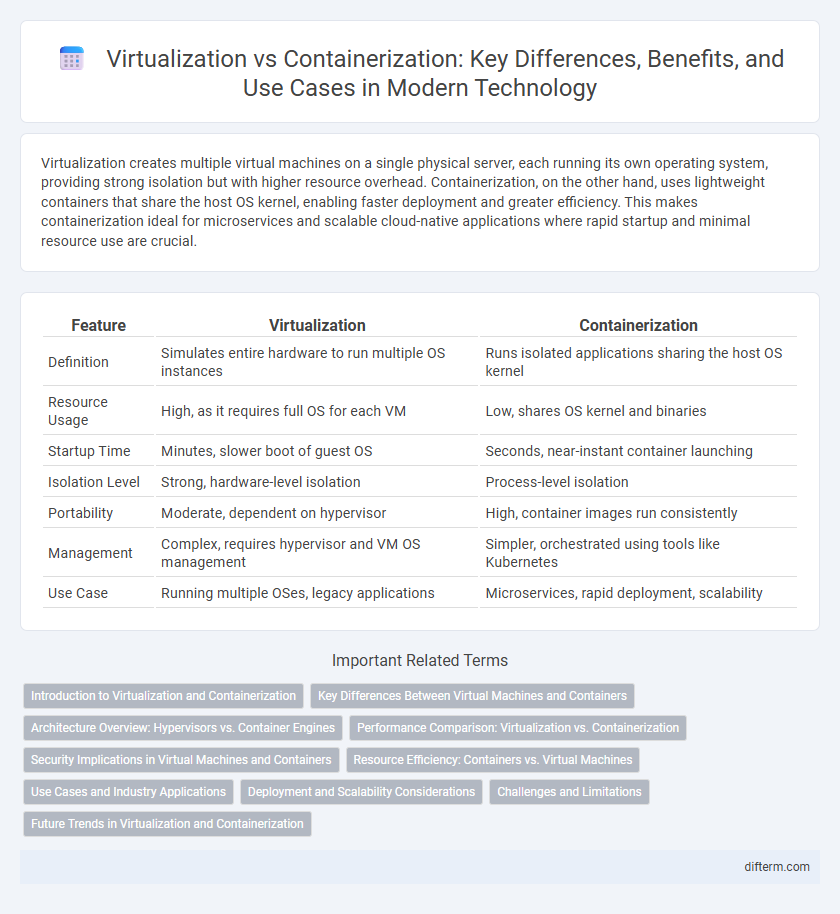Virtualization creates multiple virtual machines on a single physical server, each running its own operating system, providing strong isolation but with higher resource overhead. Containerization, on the other hand, uses lightweight containers that share the host OS kernel, enabling faster deployment and greater efficiency. This makes containerization ideal for microservices and scalable cloud-native applications where rapid startup and minimal resource use are crucial.
Table of Comparison
| Feature | Virtualization | Containerization |
|---|---|---|
| Definition | Simulates entire hardware to run multiple OS instances | Runs isolated applications sharing the host OS kernel |
| Resource Usage | High, as it requires full OS for each VM | Low, shares OS kernel and binaries |
| Startup Time | Minutes, slower boot of guest OS | Seconds, near-instant container launching |
| Isolation Level | Strong, hardware-level isolation | Process-level isolation |
| Portability | Moderate, dependent on hypervisor | High, container images run consistently |
| Management | Complex, requires hypervisor and VM OS management | Simpler, orchestrated using tools like Kubernetes |
| Use Case | Running multiple OSes, legacy applications | Microservices, rapid deployment, scalability |
Introduction to Virtualization and Containerization
Virtualization involves creating multiple simulated environments or dedicated resources from a single physical hardware system, enabling efficient workload management and hardware utilization through hypervisors. Containerization encapsulates applications and their dependencies into lightweight, portable containers sharing the host operating system kernel, facilitating rapid deployment and consistency across various environments. Both technologies optimize infrastructure usage but differ in isolation, resource allocation, and overhead, with virtualization offering full OS isolation and containerization providing OS-level virtualization.
Key Differences Between Virtual Machines and Containers
Virtual machines (VMs) run a full guest operating system with their own kernel on a hypervisor, providing strong isolation but consuming more resources compared to containers. Containers share the host operating system's kernel, offering lightweight, faster startup times and efficient resource usage while maintaining application-level isolation. Key differences include VMs supporting heterogeneous OS environments and containers excelling in portability and scalability, making them ideal for microservices and continuous deployment.
Architecture Overview: Hypervisors vs. Container Engines
Hypervisors create and manage virtual machines by abstracting hardware resources, allowing multiple operating systems to run simultaneously on a single physical host. Container engines, such as Docker and Kubernetes, operate at the OS level, sharing the host kernel while isolating applications in lightweight containers for improved efficiency. The architectural difference results in hypervisors offering stronger isolation with higher resource overhead, whereas container engines deliver faster startup times and better scalability due to reduced virtualization layers.
Performance Comparison: Virtualization vs. Containerization
Virtualization incurs higher overhead due to full guest OS instances running on hypervisors, resulting in increased resource consumption and slower startup times. Containerization leverages shared host OS kernels, providing lightweight isolation that delivers near-native performance with minimal latency. Benchmarks show containers can initiate in milliseconds while VMs require seconds, making containers ideal for high-density, performance-critical applications.
Security Implications in Virtual Machines and Containers
Virtual machines (VMs) offer strong security isolation by using hypervisors to separate guest operating systems, reducing the risk of cross-VM attacks. Containers share the host OS kernel, which can increase vulnerability exposure, but implementing namespaces, control groups (cgroups), and runtime security tools like AppArmor or SELinux enhances container security. Regularly updating container images and using container-specific security platforms like Aqua or Twistlock are crucial for mitigating containerization risks compared to traditional virtualization.
Resource Efficiency: Containers vs. Virtual Machines
Containers utilize OS-level virtualization, sharing the host operating system kernel, which significantly reduces overhead and leads to higher resource efficiency compared to virtual machines that require full guest operating systems. Virtual machines allocate dedicated CPU, memory, and storage resources to each instance, resulting in greater resource consumption and slower performance. This efficient resource utilization makes containers ideal for scalable cloud-native applications and microservices architectures.
Use Cases and Industry Applications
Virtualization enables multiple operating systems to run on a single physical server, making it ideal for data centers and enterprises requiring isolated environments for legacy applications and resource-intensive workloads. Containerization offers lightweight, portable environments optimized for microservices, continuous integration/continuous deployment (CI/CD) pipelines, and cloud-native applications in industries like finance, healthcare, and e-commerce. Both technologies enhance infrastructure efficiency, but containerization excels in scalability and rapid deployment for modern application development.
Deployment and Scalability Considerations
Virtualization enables deployment of multiple operating systems on a single physical server, providing robust isolation but often with higher resource overhead and slower scalability. Containerization leverages lightweight containers sharing the host OS kernel, allowing faster deployment cycles and more efficient horizontal scaling in dynamic cloud environments. Scalability in containerized systems benefits from orchestration tools like Kubernetes, which automate resource allocation and load balancing across clusters, unlike traditional virtual machines that may require manual scaling and more provisioning time.
Challenges and Limitations
Virtualization faces challenges such as high resource overhead and slower performance due to hardware emulation, which impacts scalability in large-scale deployments. Containerization, while lightweight and efficient, can suffer from security vulnerabilities as containers share the host OS kernel, leading to potential isolation issues. Both technologies encounter limitations in managing complex network configurations and persistent storage, requiring advanced orchestration tools to ensure consistent performance and security.
Future Trends in Virtualization and Containerization
Future trends in virtualization and containerization emphasize enhanced integration with edge computing and AI-driven orchestration for improved scalability and resource efficiency. Hybrid models combining virtual machines and containers support diverse workloads, enabling seamless migration and optimized performance in multi-cloud environments. Security advancements focus on isolation techniques and runtime protection to address evolving cyber threats in virtualized and containerized infrastructures.
virtualization vs containerization Infographic

 difterm.com
difterm.com